Key takeaways:
- Classical Chinese Dance intertwines movement with cultural storytelling, emphasizing the emotional connection through gestures.
- Teaching dance cultivates discipline, resilience, and a sense of community, enriching both personal and collective experiences.
- Incorporating visual learning and storytelling into lessons enhances student engagement and understanding of the dance’s historical context.
- Feedback from students is vital for adjusting teaching methods and fostering a supportive learning environment.
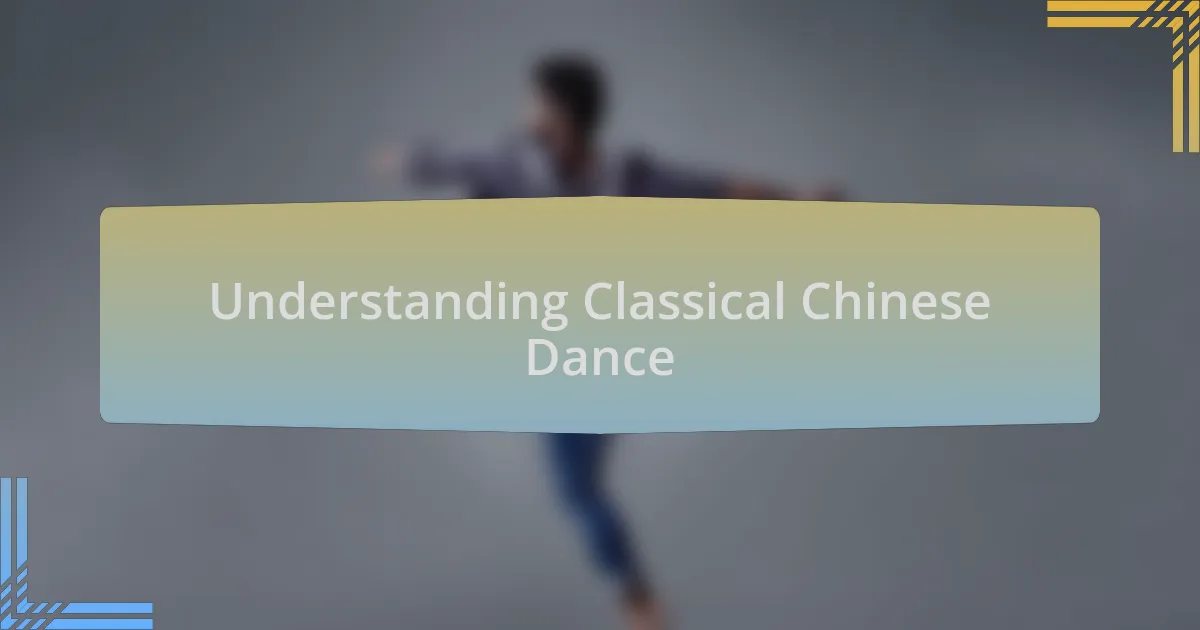
Understanding Classical Chinese Dance
Classical Chinese Dance is not just about movement; it embodies centuries of culture, philosophy, and artistry. When I first encountered the grace of this dance form, I felt a profound connection to the stories it tells—a reminder of how dance can express emotions that words often fail to capture. Have you ever watched a dancer and felt as if they were revealing a piece of their soul?
Each gesture and expression in this dance tradition carries meaning, often derived from ancient texts and spiritual beliefs. I remember teaching a group of beginners, and one student asked why certain arm movements seemed so rigid while others flowed so freely. It struck me how much understanding can enhance appreciation; those “rigid” forms symbolize strength and control, a testament to the dancer’s discipline and inner focus.
The music that accompanies classical Chinese dance plays a crucial role in guiding the rhythm and emotions of the performance. I vividly recall a performance where the violin’s sorrowful notes intertwined with the dancer’s movements, creating a narrative that left me breathless. This seamless blend of sound and movement invites you to not just watch but to feel—don’t you think that’s what makes art so powerful?
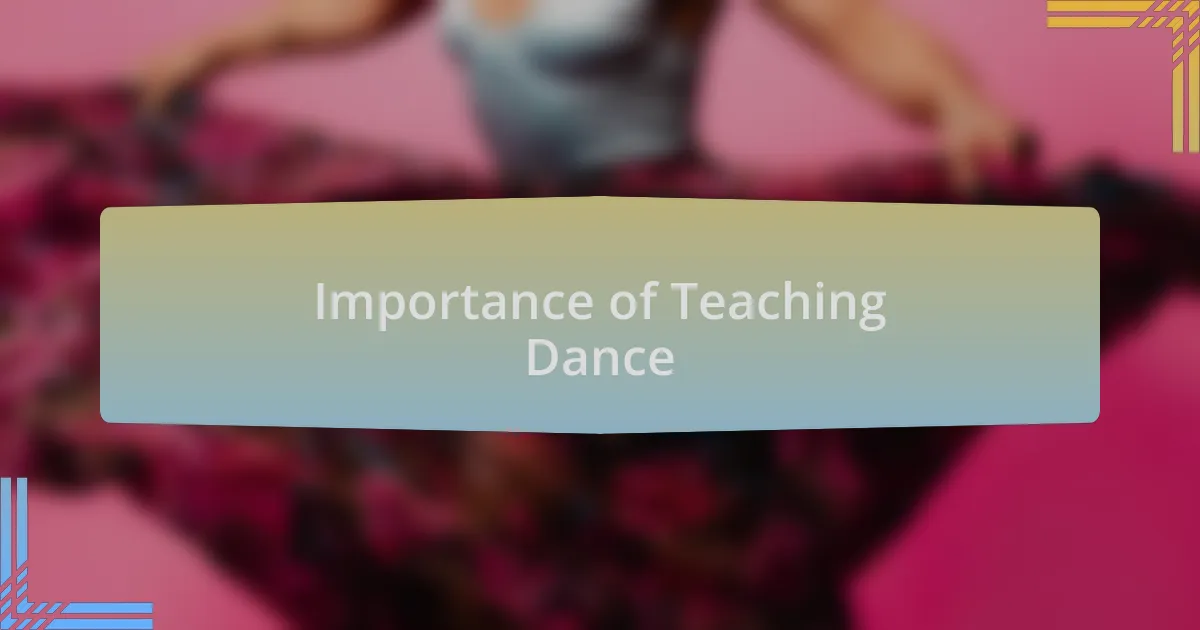
Importance of Teaching Dance
Teaching dance is incredibly important because it fosters a deep connection between the dancers and their cultural heritage. I recall a moment when a student hummed along to a traditional piece while practicing a routine. That simple act highlighted how teaching dance is not just about technique; it’s about embedding history and identity into every movement.
Moreover, teaching classical Chinese dance allows individuals to develop discipline and perseverance. In one of my classes, a student struggled with mastering a particular jump, becoming frustrated with the process. I shared my own challenges from years ago, and seeing her eyes light up in understanding was magical. It reminded me that the journey of learning can cultivate resilience—something that transcends the dance floor.
Finally, the act of teaching dance creates a sense of community. When I hosted a workshop, participants from different backgrounds shared their experiences and stories, all connected through the art of movement. Have you ever felt that unifying energy in a group setting? It’s a profound reminder that while each dance tells a story, teaching it creates a chorus of shared experiences that enriches everyone involved.
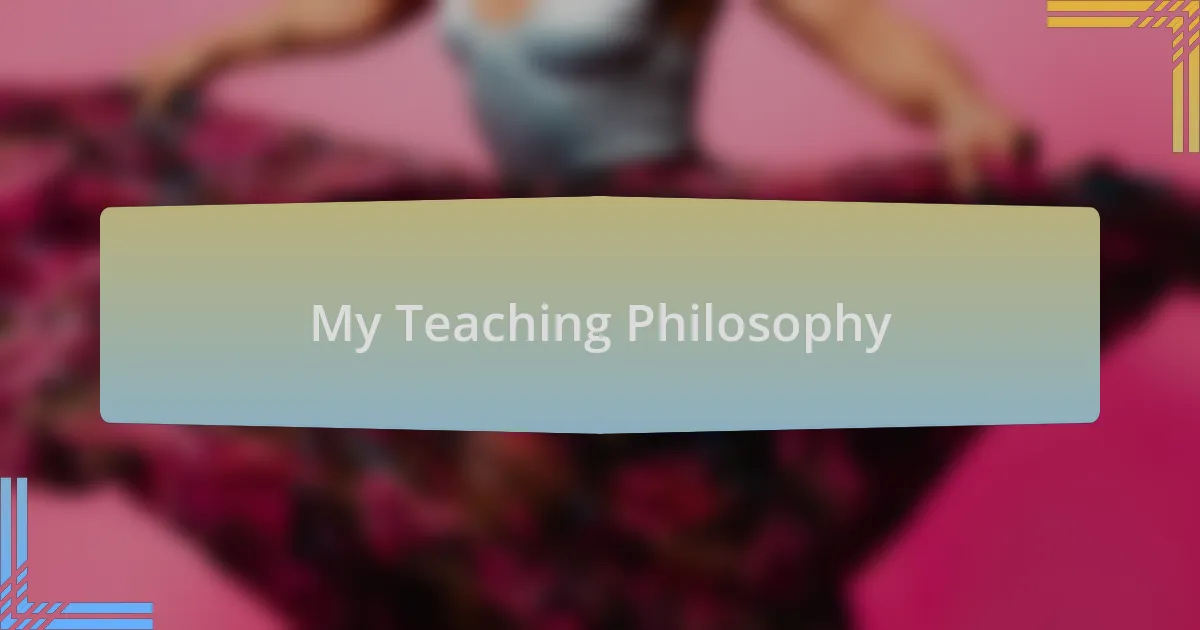
My Teaching Philosophy
Teaching, to me, is not just about imparting knowledge; it’s about inspiring growth. I always emphasize that every dancer has their unique path. I remember one student who showed an affinity for storytelling through her movements but felt unsure about expressing herself. As I encouraged her to explore her own narrative, I realized that fostering creativity is as essential as perfecting technique—it’s what truly resonates on stage.
Another key aspect of my teaching philosophy revolves around building trust. I strive to create an atmosphere where students feel safe to share their vulnerabilities. One day, a shy student admitted she struggled with performing in front of others. I shared my own experiences of stage fright and how I learned to embrace those nerves. That moment of honesty opened the door for her to take risks, and witnessing her newfound confidence was incredibly rewarding.
Ultimately, I believe that teaching dance is a collaborative experience. I often ask my students for feedback on our classes, encouraging them to voice their thoughts. This dialogue not only refines my approach but also empowers them to take ownership of their learning journey. Have you ever noticed how a simple conversation can spark a breakthrough? I find that by valuing their perspectives, we create a richer learning environment together.
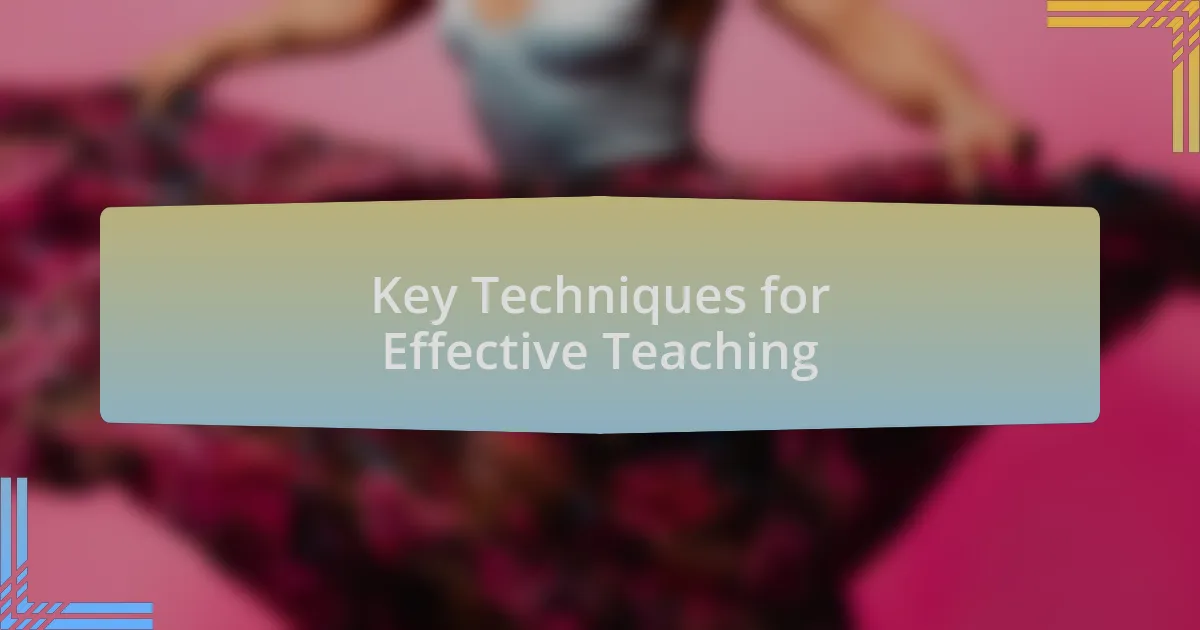
Key Techniques for Effective Teaching
One essential technique for effective teaching is to break down complex movements into manageable steps. I recall a time when I was teaching a challenging sequence of turns. Instead of overwhelming my students with the entire routine, I focused on mastering one turn at a time. The satisfaction on their faces as they achieved each small milestone reminded me how crucial it is to celebrate progress, no matter how minor it may seem.
Another critical element is the power of visual learning. I often incorporate demonstrations, as I believe watching a technique in action can ignite understanding and clarity. There was a student who struggled with the concept of balance in a pirouette. After demonstrating the movement, I could see her eyes light up; it was like a light bulb went off. Engaging visual aids or examples not only clarify my teaching but also leave a lasting impression on my students’ minds. Don’t you think seeing something in motion makes it easier to grasp?
Additionally, I’ve found that incorporating storytelling into lessons can significantly enhance engagement. When I share the cultural background behind a specific dance routine, it transforms the way students relate to the movements. I once shared the myth behind a graceful hand gesture, and the room was captivated. It became more than just a physical action; it became a piece of art filled with emotion and meaning. Isn’t it fascinating how we can connect history and dance, making each lesson a rich tapestry of knowledge?
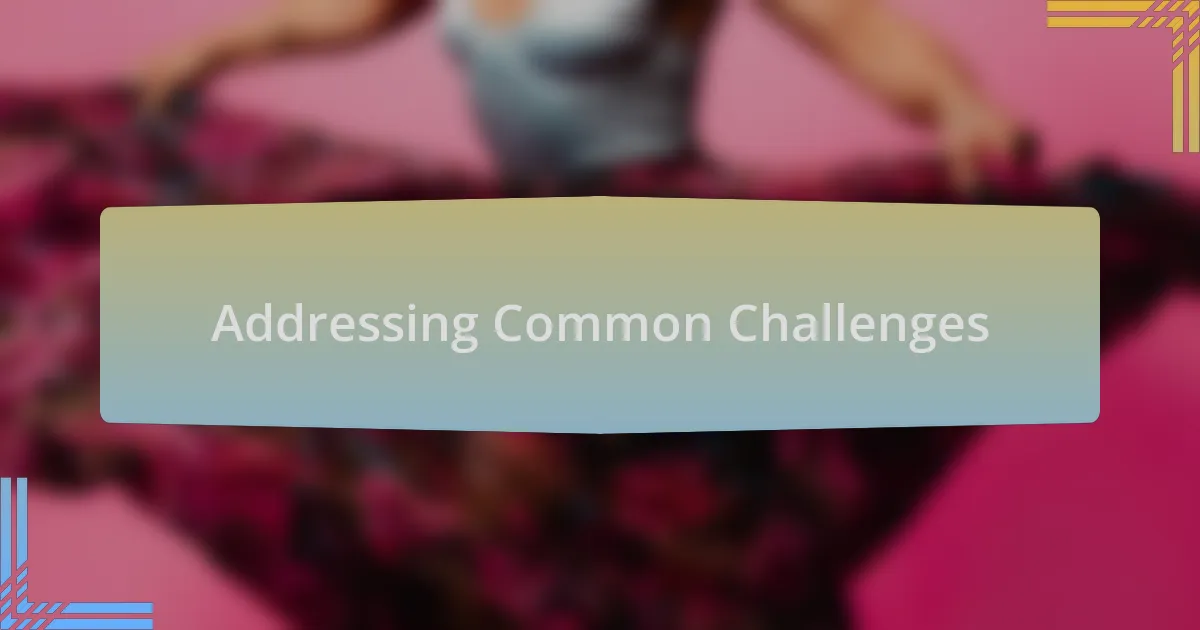
Addressing Common Challenges
I’ve often encountered students who struggle with self-confidence, especially when trying new movements. I remember one particularly shy student who would hesitate before even taking a step. During one class, I shared my own struggles with stage fright and how performing still felt daunting at times. Gradually, she opened up, and I could see her confidence bloom as she embraced her own journey. Isn’t it incredible how vulnerability can create a safe space for growth and connection?
Another challenge that arises in teaching is ensuring individual progress while managing group dynamics. In one of my classes, I had a diverse group of skill levels, which created a balancing act for me. To address this, I implemented a buddy system where more experienced dancers partnered with beginners. Surprisingly, both sides learned immensely from this interaction. While the beginners received guidance, the skilled dancers enhanced their understanding by explaining techniques. Have you ever considered how teaching others can also solidify your own knowledge?
Finally, time management often poses a challenge when teaching complex choreography. I recall a class where I underestimated the time needed to learn a new routine. As the clock ticked down, I could feel the pressure and anxiety building in the room. So, I shifted my focus, choosing to simplify the choreography to meet the class’s needs, allowing us to master it rather than rush through. This experience reminded me that flexibility in teaching methods is essential; sometimes, it’s better to take a step back and ensure a strong foundation than to push forward hastily. Isn’t it worth adapting our approach to truly benefit our students?
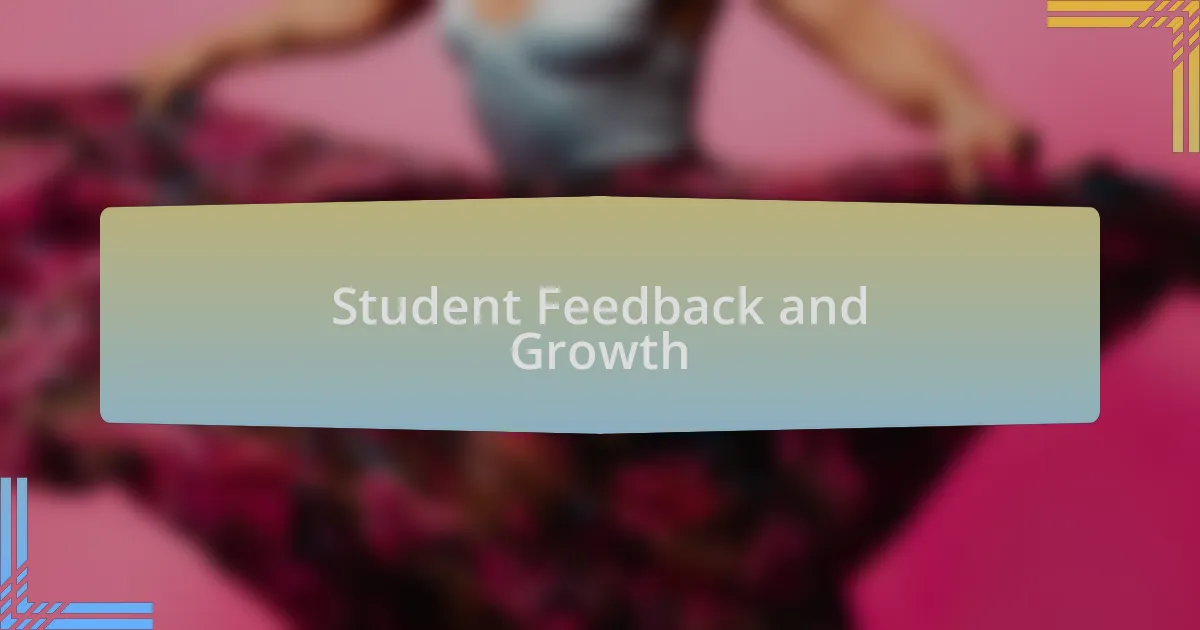
Student Feedback and Growth
When it comes to gathering feedback from my students, I find it to be a crucial aspect of our growth journey together. I once asked my class to share their thoughts on a particular piece we had been working on. Their responses were enlightening, revealing not only what they struggled with but also the moments that inspired them. It’s amazing how opening up that dialogue not only helped them feel heard but also provided me with insights to tailor my teaching approach. What if every feedback session could feel like a collaborative growth experience?
I vividly recall a student who had previously felt disconnected from a group performance. After our conversation, she took the initiative to practice with others outside of class hours, and the transformation was heartwarming. Watching her evolve from feeling isolated to becoming a supportive team player made me realize the powerful impact of a supportive learning environment. Have you ever thought about how much potential lies in simply encouraging students to communicate their needs and ideas?
Reflecting on student feedback also allows me to assess my effectiveness as a teacher. I remember making adjustments to a lesson after hearing a student express that they needed more visual cues. The next class, I incorporated more demonstrations, and the improvement in their understanding was palpable. It struck me that this two-way street of feedback is essential; it helps create a richer learning atmosphere where both students and teachers can thrive. Isn’t it fascinating how feedback can serve as a catalyst for shared success?